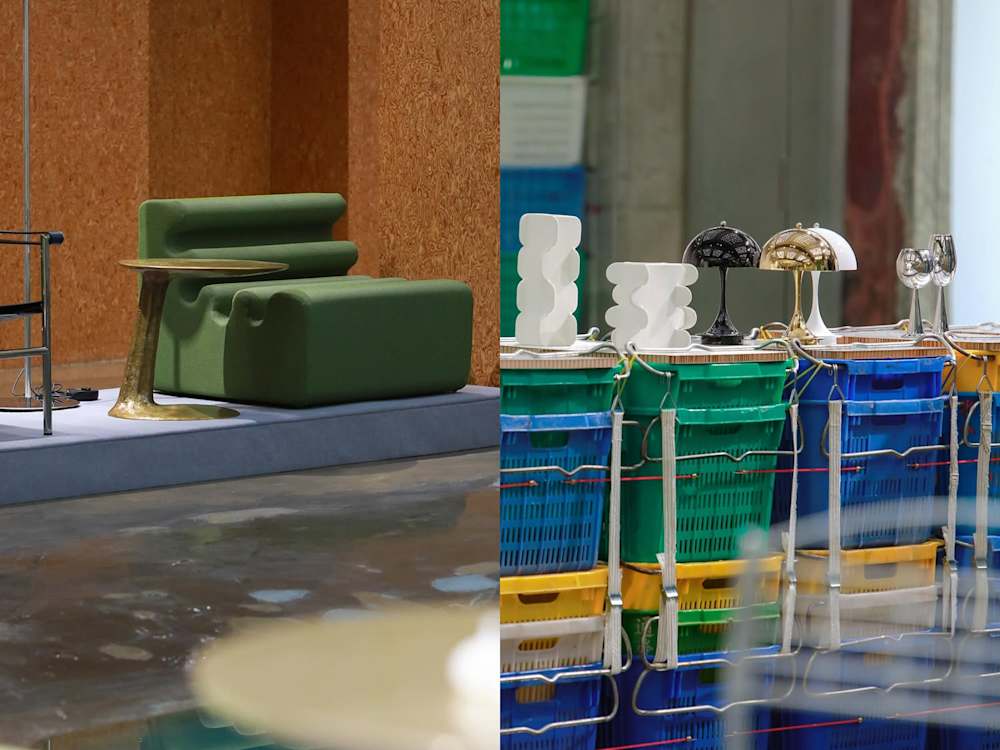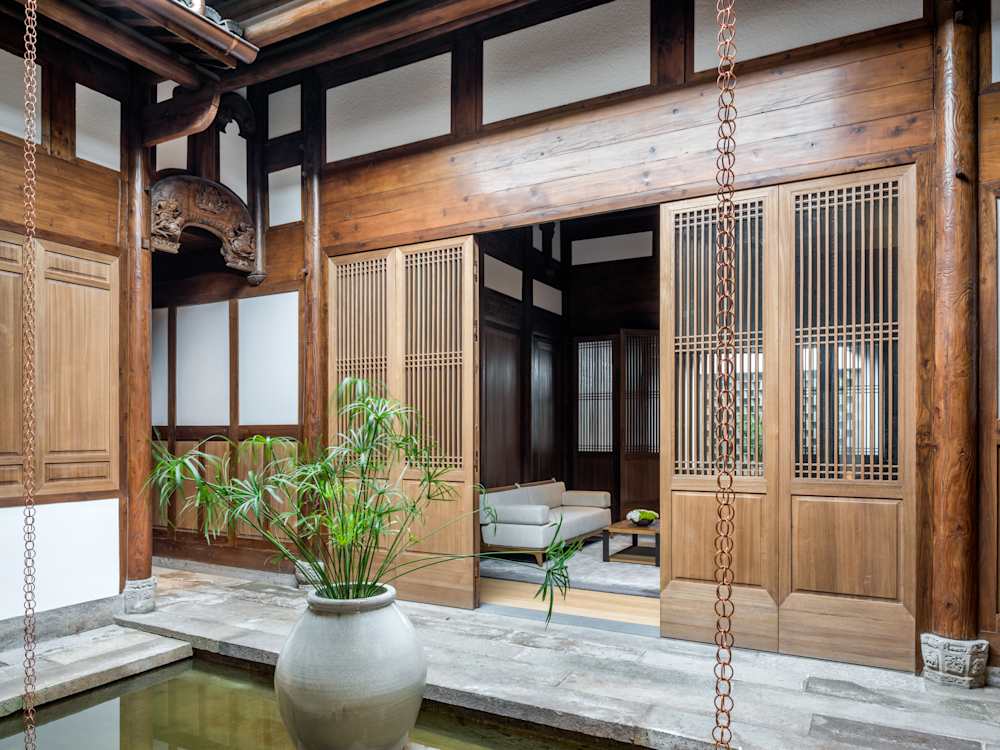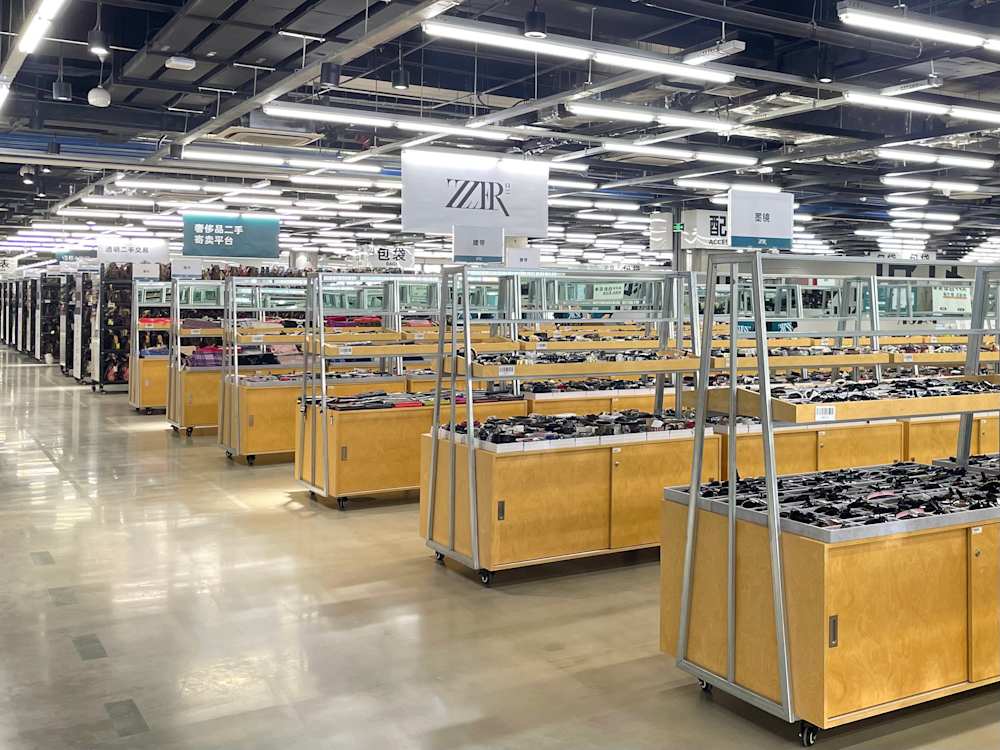Shanghai offers two cities in one. Look up, and you’re in a megacity from the future, with seemingly endless skyscrapers, some hiding sculpted roof gardens. On street level, it’s a city of traditional ‘mom-and-pop’-style dumpling houses, Buddhist temples and sleepy, tree-lined streets. It’s on these streets that you can wander and discover, as I did, expertly curated boutiques, old-school food markets and quirky coffee shops (fun fact: Shanghai has the most coffee shops of any city in the world.) Then, there are the many malls: abundant, a beloved pastime for locals and usually open late. Here, history and culture play backdrop to a fashion lover’s paradise.
When it comes to shopping, much of the action takes place around the Jing’an area, so it makes sense to book a stay at Upper House Shanghai, a luxury hotel right in the centre of the city, which fuses Chinese and European architecture and design. Think Shanghai’s Shikumen architecture on the outside, with sleek, elegant interiors. From here, you can walk the surrounding neighbourhood and discover a shopping experience easily on a par with New York City or Paris. But to do so, you’ll need a trusty map to guide you: Google Maps with a VPN, or Chinese favourite, Bing, as well as downloading the apps WeChat or AliPay, since credit cards are rarely accepted. You’ll also need this trusted list of the best places to shop for the most unique finds.
Concept stores for the fashion curious

XC723
For me, Shanghai’s concept stores were the highlight, presenting high fashion within impressive post-industrial architecture. Take XC723: a former towel factory converted by Shanghai studio Dongqi Design into a series of fashion showrooms set within marble walls and overlooking a shallow pool in the building’s dramatic atrium. Along with new collections from brands like Acne and Lemaire, this store stocks homegrown talent like Samuel Guì Yang, a Central Saint Martins graduate who has reinvented traditional Chinese cuts for the modern woman. On the top floor, you’ll find a treasure trove of rare vintage Maison Margiela and Raf Simons-era Prada.
For more design to marvel at, head over to The Haus Shanghai — aka Haus Nowhere — which places a retail experience within an immersive, robotic art installation. Here, you’ll find Gen Z streetwear kids seeking out South Korean eyewear innovators Gentle Monster and fragrance forerunners Tamburins. While Haus Nowhere has already set up similar multi-floor concept stores in Seoul and Shenzen, there’s nothing quite like it in the UK.
For those seeking homewares alongside a fashion offering, Maison Dongliang is a historic villa in Changning with leafy gardens. The perfect place to peruse Ann Demeulemeester’s Serax tableware, Chinese ceramicist Jingwen Wu’s earthy vases, or an entire room of The Row. While The Row isn’t quite in my price range, I did enjoy a herbal tea before exploring the rooms of this beautifully preserved building, as any fashion lover must: as though at an art museum.
Independent boutiques
As you’re wandering around the Jing’an neighbourhood, you may notice multiple branches of a store called Labelhood. Don’t walk by — Labelhood was conceived by Chinese fashion entrepreneur Tasha Liu in 2016 to nurture and showcase young Chinese designers like Mark Gong and Jacques Wei; and to reimagine the meaning of ‘made in China’, to focus on small brands that are centred on craft and sustainability. Labelhood may capture the charm of shopping in Shanghai: peaceful, immaculate stores with helpful staff, but it’s not the only must-visit store locally. A few blocks west of Jing’an is In the Park boutique, an impeccable mini department store stocking streetwear, from the recognisable (Asics) to the more obscure (Xander Zhou). Then, a few blocks north is Xian Suo Creative Park (No 60, Lane 273, Jiaozhou Road) — the perfect place to explore independent purveyors of art books, plants and bicycles. Although the latter may not fit in your suitcase.
The best spots for luxury lovers

Amanyangyun
As the financial capital of China, Shanghai found itself at the heart of the country’s economic boom post-2000. As spending on luxury brands skyrocketed, malls were built to meet the demand, places where dining, entertainment and shopping converge. Take the IFC Mall, built between 1998 and 2006, is a sprawling 110,000-square-metre and six-storey shopping mall near waterfront district, The Bund, the banks of which are the best place to admire the city’s distinct skyline. While in other parts of the world we might associate malls with bustling food courts, in Shanghai they play host to some of the city’s best dining opportunities. Jing’an Kerry Centre (No 1515 Nanjing Road West in Jing’an District), for instance, features all the luxury favourites, from Bottega Veneta to Balenciaga, with the yakitori restaurant Torisawa on site to satiate you after a long day spent shopping, with cocktails provided by the mixologists behind local-favourite bar Speak Low (although personally, I skipped dinner and headed straight to the bar’s moody and atmospheric original location on Fuxing Middle Road).
Post-designer splurge, for further relaxation, luxury lovers should stay at Amanyangyun. The cult hotel brand’s Shanghai location presents the option of Ming Courtyard Suites, each with an alfresco bath tub; or book one of its antique pavilions, set within the grounds of an ancient camphor tree forest. Here, you’ll forget the hustle and bustle of the city and connect with nature, especially once you experience a salt scrub down in the hammam or the delights of the Russian banya.
Souvenir hunting Shanghai style
For a down-to-earth shopping experience, leave the luxury behind and visit some of the older haunts in the city, like Yuyuan Old Street, where the traditional pavilions are illuminated at night (a great photo opportunity), and where you can buy Chinese tea, Yixing clay teapots and jade jewellery, all while breathing in the scent of steaming street food. Or head to Hongqiao Pearl Market (No 3721 Hongmei Road, Changning District) to haggle on necklaces, chopsticks, and fabrics (note, this mall is unassuming, and most of the shops can be found upstairs, confusingly). I did most of my souvenir shopping at Shanghai First Food Mall (No 1 Century Avenue, Pudong New Area), situated on the busy commercial shopping street of Century Avenue. Think Harrod’s food hall but with the best of Chinese confectionery, including White Rabbit candy and Palmiers (Hu Die Su, locally), a famous delicacy in Shanghai since France established a French Concession in Shanghai between 1849 and 1943.
To absorb said French architecture, I’d also recommend a visit to arts and crafts area, Tianzifang, within the old French Concession. A little like Shanghai’s answer to Camden Market, Tianzifang is a narrow area of streets with market stalls, bars and food stands, and — much like Camden — it seems to have given way from the antique and alternative to generic tourist fare. Still, it’s worth a visit for atmosphere alone, and here you might eat much of what you buy before you leave: the perfect scallion, egg and chilli-oil noodles cost £1.50 and were unforgettable.
Second-hand spots

ZZER
Finally, it might also be amiss not to mention the fact that there is a side to Shanghai where designer copies — for better or worse — abound. While, for legal reasons, I’ll leave you to do your own research, I will point you in the direction of the not-so-secret, second-hand luxury bag warehouse ZZER, aka R Warehouse. This, China’s largest, pre-loved, luxury-designer store sells bags and jewellery from brands like Dior, Chanel and Louis Vuitton. Thankfully, this huge consignment warehouse is meticulously organised by brand and then colour, although that doesn’t change the fact that you could lose half a day here.
If the aforementioned joy of Shanghai is its blend of modern and traditional, the best shopping experiences I discovered were those like ZZER, which lie somewhere in between, and were unlike anything I had experienced before. Shanghai might be a luxury hub that has found itself on the map due to the growth of Shanghai Fashion Week and a slew of international fashion shows, like Balenciaga Spring 2025. However, its grassroots fashion and upcoming designers are what make it a hotspot for the acquisitive. Often the items to be treasured are found at vintage stores where everything is customised, a chance sample sale or a tiny boutique selling underground brands, down a back alley in an unassuming street.
Most of the time, I was too busy bargain hunting to take down the names. But that might be a good thing, if it encourages you to find your own slice of Shanghai fashion. After all, there truly is something for everyone, and critically, at every possible price point.
Need somewhere to stash your shopping haul? See our full collection of hotels in Shanghai



